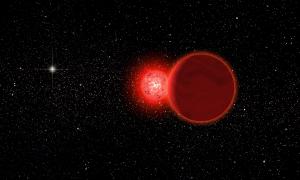Blog
Missed It By That Much
20 February 2015
 Michael Osadciw / University of Rochester
Michael Osadciw / University of RochesterBack in December I wrote about a star heading our way. It’s nothing to worry about, but it demonstrated that stars can come relatively close to our solar system on long time scales. Now new research finds that one close approach occurred just 70,000 years ago.1
The star is known as Scholz’s star, and is a small red dwarf star with a brown dwarf companion. Currently it is about 20 light years from the Sun, but 70,000 years ago it was only 52,000 AU away, or about 0.8 light years. That might not seem particularly close, but the outer edge of the Oort cloud likely extends farther than that, so the star could have gravitationally perturbed Oort cloud objects, sending some toward the inner solar system.
Some of you might look at that 70,000 BC date and wonder if this might have anything to do with the “bottleneck theory” of human evolution, where the human population supposedly winnowed to about 10,000 individuals. The answer is no for two reasons. The first is that genetic evidence for a 70,000 BC bottleneck is not particularly strong, the second is that any cometary bodies perturbed by the close encounter would take time to reach us. In this case, the trip from the outer Oort cloud to the inner solar system is about 2 million years. So there might be a slight uptick in comets in a couple million years, but the team estimates that this won’t be significant.
The work also puts doubt on the upcoming close encounter of HIP 85605 I wrote about in December. It seems the distance of HIP 85605 was underestimated by a factor of 10, which means it won’t come nearly as close as we thought. If that’s the case, then Scholz’s star marks the closest stellar approach known. The number and distance of these kinds of close encounters are likely to change a bit as we continue to get better data on close faint stars. For example, when the Gaia spacecraft becomes active we’ll have position and motion data of more than a billion stars.
Mamajek, Eric E., et al. “The closest known flyby of a star to the solar system.” The Astrophysical Journal Letters 800.1 (2015): L17. ↩︎